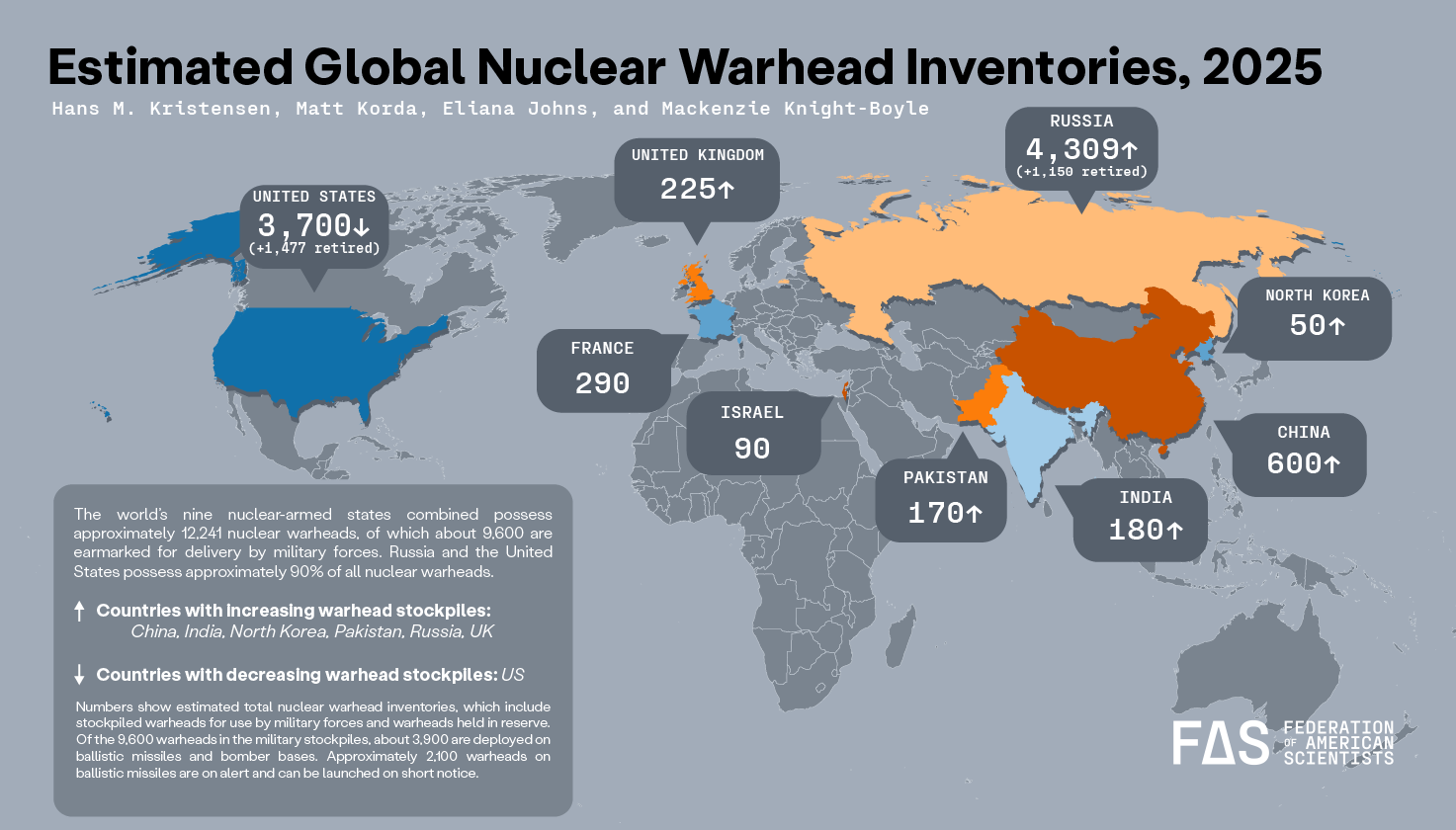
Status of World Nuclear Forces
Who owns the world’s nuclear weapons?
Despite progress in reducing nuclear weapon arsenals since the Cold War, the world’s combined inventory of nuclear warheads remains at a very high level: nine countries possessed roughly 12,241 warheads as of the beginning of 2025.
Combined, the United States and Russia now possess approximately 87 percent of the world’s total inventory of nuclear weapons, and 83 percent of the stockpiled warheads available for use by the military. Currently, no other nuclear-armed state sees a need for more than a few hundred nuclear weapons for national security, although many of these states are increasing their nuclear stockpiles.
Globally, the overall inventory of nuclear weapons is declining, but the pace of reductions is slowing compared with the past 30 years. Moreover, these reductions are happening only because the United States and Russia are still dismantling previously retired warheads.
In contrast to the overall inventory of nuclear weapons, the number of warheads in global military stockpiles – which comprises warheads assigned to operational forces – is increasing once again. The United States is still reducing its nuclear stockpile slowly. France and Israel have relatively stable inventories. But China, India, North Korea, Pakistan and the United Kingdom, as well as possibly Russia, are all thought to be increasing their stockpiles (see map below, click here for higher resolution image):

Note: arrows refer to general trends over a multi-year period, rather than individual year-to-year changes. Numbers may fluctuate year-over-year for several reasons, including actual changes in a countries’ stockpiles and/or reassessments by the authors based on new data.
Of the world’s approximate 12,241 nuclear warheads, roughly 9,614 are in the military stockpiles for use by missiles, aircraft, ships and submarines. The remaining warheads have been retired but are still relatively intact and are awaiting dismantlement). Of the 9,614 warheads in the military stockpiles, some 3,912 are deployed with operational forces (on missiles or bomber bases). Of those, approximately 2,100 US, Russian, British and French warheads are on high alert, ready for use on short notice (see table):
The exact number of nuclear weapons in each country’s possession is a closely held national secret, so the estimates presented here come with significant uncertainty. Most nuclear-armed states provide essentially no information about the sizes of their nuclear stockpiles. Yet the degree of secrecy varies considerably from country to country. Between 2010 and 2018, the United States disclosed its total stockpile size, but in 2019 the Trump administration stopped that practice. In 2020, the Biden administration restored nuclear transparency – a brief victory for nuclear accountability in a democratic country – but then declined to declassify any US stockpile data for 2021, 2022, or 2023. Similarly, in 2021 the United Kingdom announced that it would no longer disclose public figures for its operational stockpile, deployed warhead or deployed missile numbers. Additionally, in 2023 both the United States and Russia elected to no longer exchange publicly-available data about their deployed strategic warheads and launchers as mandated by the New START Treaty.
Despite these limitations, however, publicly available information, careful analysis of historical records, and occasional leaks make it possible to make best estimates about the size and composition of the national nuclear weapon stockpiles. For a breakdown of the nuclear warhead categories of the different nuclear-armed states, and for links to more details overviews of each country’s arsenals, see this table:
In historical context, the number of nuclear weapons in the world has declined significantly since the Cold War: down from a peak of approximately 70,300 in 1986 to an estimated 12,241 at the beginning of 2025. Government officials often characterize that accomplishment as a result of current or recent arms control agreements, but in reality the overwhelming portion of the reduction happened in the 1990s. Some also compare today’s numbers with those of the 1950s, but that is like comparing apples and oranges; today’s forces are vastly more capable.
The pace of reduction has slowed significantly compared with the 1990s and appears to continue only because of dismantlement of retired weapons; the trend is that the military stockpiles (useable nuclear weapons) are increasing again.
Instead of planning for nuclear disarmament, the nuclear-armed states appear to plan to retain large arsenals for the indefinite future. As such, they are in conflict with the objective and spirit of the Treaty on the Non-Proliferation of Nuclear Weapons.
All continue to modernize their remaining nuclear forces at a significant pace, several are adding new types and/or increasing the role they serve in national strategy and public statements, and all appear committed to retaining nuclear weapons for the indefinite future.
For an overview of global modernization programs, see our contributions to the SIPRI Yearbook and the Nuclear Weapons Ban Monitor. Individual country profiles are available from the FAS Nuclear Notebook in the Bulletin of the Atomic Scientists.
The information available for each country varies greatly, ranging from the most transparent nuclear weapons state (United States) to the most opaque (Israel). Accordingly, while the stockpile estimate for the United States is based on “real” numbers, the estimates for several of the other nuclear-armed states are highly uncertain.
These nuclear weapons estimates are produced by Hans M. Kristensen, Matt Korda, Eliana Johns, and Mackenzie Knight-Boyle of the Federation of American Scientists. Their work is based on the pioneering accomplishments of analysts Thomas Cochran, Robert Norris, and William Arkin, without whom this public service would not be possible.
This work is made possible through grants from the Carnegie Corporation of New York, the New-Land Foundation, the Prospect Hill Foundation, Ploughshares, and individual donors. The statements made and views expressed are solely the responsibility of the authors.